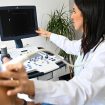The electromyogram (EMG) monitors the function of the peripheral nerves, i.e. the nerves of the body except those of the brain and spinal cord, and the function of the muscles and the neuromuscular junction, in other words the point where the nerve "joins" the muscle.
For the first time, Electromyographic methods were applied in the USA. Physiatrists and later neurologists also considered this method. Today, EMG is used internationally by some Physiatrists and some Neurologists. It is a purely medical procedure, because at the conclusion of a reliable diagnosis, clinical symptoms must be taken into account.
The usefulness of EMG is important in many diagnostic problems related to the neuromuscular system, but mainly contributes greatly to the differential diagnosis of nerve entrapment (pressure) syndromes and myopathies.




